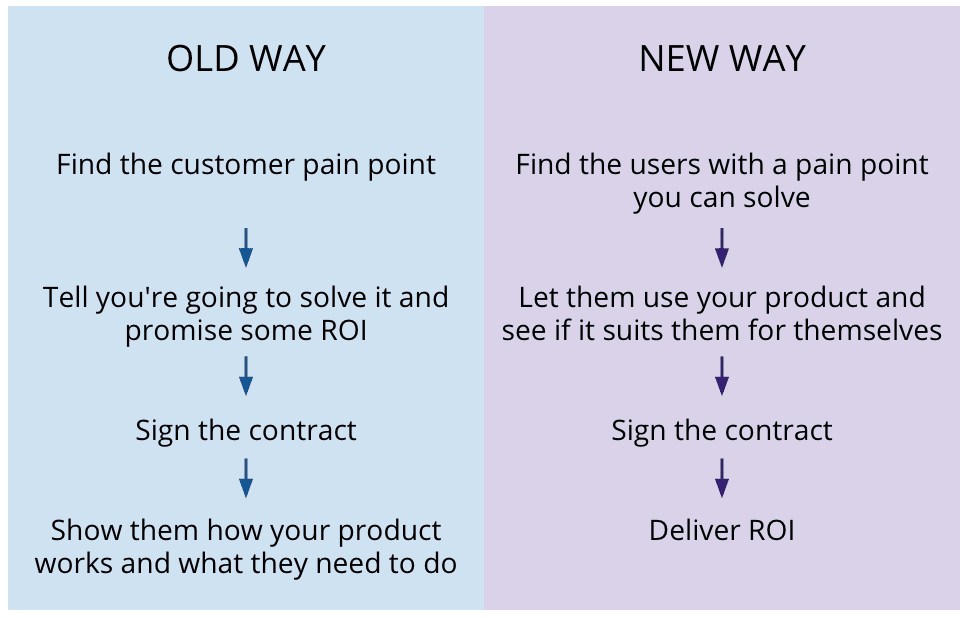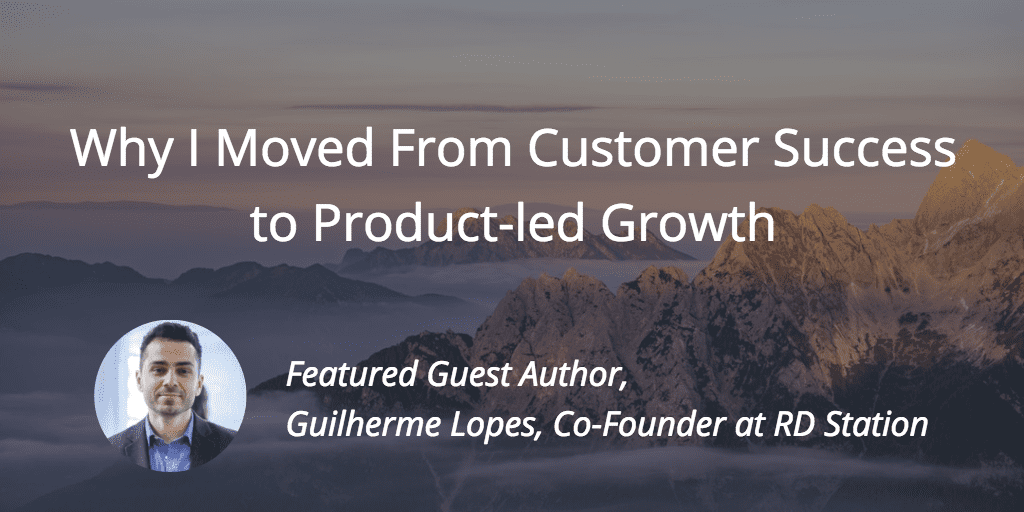Last month, I quit my position as head of Customer Success at my company, RD Station.

It was a dream job for a CS leader, if I may say so myself. In those six years leading the team, I’ve led its growth from one person to 180 people that are now spread across five different functional teams: Customer Success Manager (CSM), Partner Success Manager (PSM), Professional Services, Support, and CS Ops. We structured them around assets such as a customer outcomes map, a journey of success milestones, playbooks, dashboards, quality assurance processes, and so on. The people were exceptional! I’ve hired managers and directors from the most well-known software companies and we’ve also developed talented people from inside.
So why on earth would someone quit this position to lead a five-person team running a small project inside the same company? I’ll try to explain the reasons I think product-led growth is going to be our company’s next main growth driver.
The Upmarket Trap
RD Station is one of the fastest-growing SaaS companies in Latin America. We have thrived because we managed to build a sales machine that is scalable and predictable. By sales machine, I mean the whole process of marketing, selling, and retaining (quoting Dan Steinman: “there is no post-sale anymore, only sales”).
Many of the successful SaaS companies walked a similar path. We started by killing on marketing, attracting hordes of new leads each month. Then, we nailed the sales processes, converting thousands into customers. And yeah, we offered excellent customer service through our CS team. But once you have your one or two years of growth leap, you realize that good service is not enough to achieve the best-in-class net dollar retention rates.
So you start tweaking this sales machine because you want to make sure you’re bringing in customers that are able and committed to be successful. You add a one-year contract, start charging up front, make paid implementation service mandatory, raise the bar on your lead-scoring system, and so on.
What happens is that your CAC goes up and your ability to attract and convert leads go down. To make the numbers add up, you need even higher net dollar retention, which reinforces the need to add up barriers. So now that excellent sales machine you’ve built puts you in a trap, leaving you no other option than to increase your prices or, as many companies do, go upmarket.
Customer Success Is Not Your Product
We all know that in SaaS, businesses that take the most are often on top. That’s why we run to dominate our market, or at least our category. When we started in the marketing automation industry, we didn’t have the first mover advantage so we had to move fast to catch up with the competition. Thus we used the customer success team to make product development faster. CSMs were communicating product launches, training users, bridging the gaps when not all use cases were addressed, and explaining how to use it when the user interface wasn’t. We don’t regret, it was a tremendous play that brought us where we are today.
The problem is that we ran into serious “product debts” because of it and we are now paying high-interest rates. Moreover, those debts don’t seem to be going away, because part of the organization got this mindset hardwired in their brains: “ship it like that, CSMs can explain how it works.” After all, why spend precious P&D resources on making a customized, self-explanatory, and effective product onboard when you’re charging the customer for three months of implementation service anyways?
Since 2016, we started investing in tech touch initiatives to help solve the over-dependence on the CSM. We managed to create some outstanding campaigns and workflows, with results like 10% increased engagement. However, we soon realized that the best tech touch results don’t change the big picture; they can give you 10%, they can’t give you 10X. As Todd Eby likes to say: CS are vitamins and supplements, not antibiotics. Customer Success is not your product.
The Product-led Alternative
At RD Station, we know that we could work around those problems and sustain the growth by taking the upmarket route. However, we remain committed to our mission: to help SMBs from emerging markets to grow. That’s why we have decided to steer the ship towards a product-led growth (PLG) strategy.
Running the risk of being over-simplistic, I’d say that a main focus of PLG is offering free or inexpensive entry-level versions of your product. Not so simple is making those versions super easy to use and sticky enough to turn them into the main source of premium customers.
We’ve seen more and more of the currently fastest growing SaaS using the PLG strategy. Companies like Zoom, Slack, Dropbox, and others are making their product the main source of demand generation. Not only those companies are killing it in customer experience, but they are also reshaping the sales process.

There is no better criterion for good fitting leads than customers that are already engaged in your product. PLG allows you to loosen the filters and barriers you created for someone to sign your premium product contract. You don’t have to infer if a customer is able and willing to be successful, you will know that for sure by analyzing their usage of your entry-level offer. That means you can go after a larger market and leads that you were previously blocking, without risking your unit economics.
As usual, easier said than done. If you launch entry-level products with poor user experience, the plan might backfire. It will not only fail to generate the extra leads, but it will also turn into sales friction for your current leads. So the product team responsible for building those entry-level offers needs to be obsessed over easily solving customer pain points, time-to-value, success milestones, and retention. Guess who understand all about those things and can help with the challenge. Yep, customer success folks.
Why I Moved
The change is utterly important to us. We want to keep growing fast, with healthy unit economics, setting the bar for SaaS companies in Latin America. At the same time, we don’t want to go upmarket and break the commitment of impacting millions of SMBs in emerging markets.
RD Station wasn’t born as a PLG company, hence steering the ship won’t be easy. We have a multi-million dollar product, with margin, that drains resources and attention. Besides, we know that part of our culture and mindset will need to be changed too. That being said: who better than a founder to lead the initiative?
Before jumping into the customer success role six and a half years ago, I was leading RD’s product team. I might be a little bit rusty, I admit! But I strongly believe that by matching my experience in CS and my product background I could successfully lead this transformation.
And last but not least, I am pretty confident that I leave a well-structured team made up of exceptional people to keep dealing with the ever-evolving customer success challenges. Not easy to let go, I have to say. Fortunately last year I strengthened my whole leadership team and brought Erika Tornice, who I trust will be a great successor.
Gainsight PX is a powerful, easy, and complete solution that can drive product-led growth in your company. With Gainsight PX, you can identify the product usage patterns that correspond to buying signals and target your best growth opportunities. Schedule a demo today to see Gainsight PX in action.
